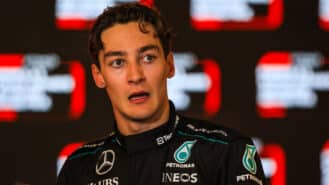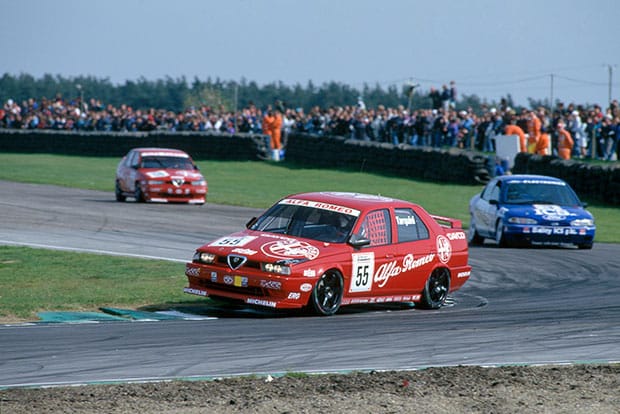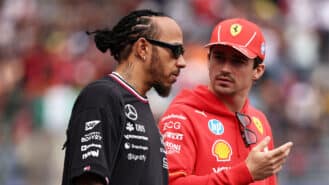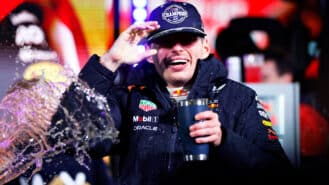
Verstappen proves Russell right: Abu Dhabi GP 2024 – Up/Down
Verstappen's prang at the first corner of the F1 finale in Abu Dhabi vindicated George Russell's recent rant

Tip-top tin-topper Gabriele Tarquini has always been as fit as a butcher’s dog. He has possessed since shedding his curly mop a marathon runner’s look: spare and lean, with bulging veins meandering across his temples.
I seem to recall his chatting about playing football for northern Abruzzo hometown Giulianova in Série C. He certainly looked the type.
We first met when he was dominating the 1994 BTCC for Alfa Romeo. The Italian marque’s big budget and homologatory approach to racing saloons were controversial, but the delightful Gabriele appeared blissfully oblivious. A happy chap by nature, that he was winning again – seven victories from eight starts during the first half of the season – made him relaxed and entertaining company.
His lilting and ever so slightly stilted English always made me smile: “I woz very arpee weeth thee car in thee first alf ov de rice. But then my fly [he meant his 155TS’s front splitter/wing] is broken and thee car is not so good in tha quickly cornas.”
We all warmed to him.
He’s rubbed paint and traded door handles ever since – he really should know better at 51 – but to be honest I didn’t pay much attention once my stint as a race reporter for Motoring News had concluded in the late 1990s. The new-format WTCC failed to grab me. Travelling halfway around the world for a couple of 12-lap crash-and-bashes has always jarred with me as damn silly.
But I was jolted by the news of Gabriele’s heavy accident at the Hungaroring last weekend: walked away, neck pains, X-rays, neck brace – it reminded me of the shunt that ended Steve Soper’s career.
Tarquini’s long motor racing involvement has been one of two alfs. For much of the first he bumped along the bottom of Formula 1 with teams like Osella, Coloni, for whom he had driven in Formula 3000, AGS and Fondmetal. For much of the second he has been cosseted in touring cars by manufacturers – Alfa Romeo, Honda, SEAT and now Honda again – more appreciative of his skill than was F1.
An Italian karting champion, there is a feeling that the man who holds an unenviable F1 record – most failures to qualify – never benefited from GP machinery worthy of him.
He did, however, shine briefly at the highest level.
In 1989, he replaced the injured Philippe Streiff at AGS, the team founded by latter day ‘Le Sorcier’ Henri Julien, racer/mechanic owner of ‘The Garage of the Future’ in Gonfaron, a French town/village in the Var region famous for breeding tortoises. You couldn’t make it up.
In a B update of designer Christian Vanderpleyn’s unfussy JH23, he qualified well at Imola – ahead of a March, a Lola, an Arrows, a Brabham, a Benetton, a Lotus, a Tyrrell and another Lola – and looked to have scored a point on his debut in the Cosworth DFR-powered chassis when two cars ahead of him were disqualified. Then they were reinstated.
Next, he stunned the establishment by recording the fifth-fastest time of Friday practice in Monaco. He wound up 13th on the eventual grid, but looked poised for a points finish when his electrics lost their vital spark after 46 laps.
That deserved point – the second and last for AGS – was swiftly bagged, however, when he fended off Eddie Cheever’s Arrows in Mexico.
He then came agonisingly close to scoring another. Thierry Boutsen’s Williams-Renault, recovering from an early puncture and struggling with a seized damper, passed the misfiring AGS for sixth place with three laps to go in Phoenix. Tarquini retook the position on the final lap when Boutsen’s gearbox all but exploded, only for his electrics to again fizzle out. Seventh.
Finally, having qualified on the back row in Montréal, he drove with panache and good sense during the early stages of a wet, wild and woolly GP to lie eighth by its fifth lap, only to be nudged off by René Arnoux’s Ligier.
It all began to slip thereafter. Forced to join the unseemly scrum of pre-qualifying in the second alf of the season, aboard a JH24 that proved disappointing, those DNQs began to rack up.
His final F1 outing was as a one-off substitute for the injured Ukyo Katayama at Tyrrell. He finished a distant 14th in the 1995 European GP at the Nürburgring. Obviously too little too late, still he smiled about it.
He was by this time the reigning BTCC champion – the first Italian to win it. His car’s raised rear ‘wing’ and two-position adjustable splitter – items of a performance kit supposedly sold with the road cars, but which Ford’s Andy Rouse could find no sign of when he bought a 155TS for reference and research – were a cover.
I recall watching a couple of Abarth mechanics, for whom a gearbox change in the mud of a rally would have been a breeze, grunt, groan and gripe as they struggled to fit said kit to a road car behind Thruxton’s paddock.
I also recall Tarquini’s inexperienced team-mate Giampiero Simoni roaring through the pack at Brands Hatch Indy despite the fact that his splitter had been smashed to smithereens.
Alfa’s advantage was wrapped up more with its active front differential, legacy of the team’s rallying expertise.
The Corse, guided by the legendary Giorgio Pianta – “I cannot-a-comment, but I say theez” – basically did a number on the eight other manufacturers contesting a series that was going global via edited TV highlights. (A much more sensible way of achieving such a thing.)
As one of its rivals muttered to me at Thruxton, scene of Tarquini’s opening win: “Even their toolbox has a better paint job than my race car.”
Given the extensive and detailed support he deserved, Tarquini obtained another quirky record: the oldest driver to win a world title sanctioned by the FIA. He was fast heading towards 48 when he became the WTCC champion in 2009.
Juan Manuel Fangio was 46 in 1957 when he became world champion for a fifth time.

Verstappen's prang at the first corner of the F1 finale in Abu Dhabi vindicated George Russell's recent rant

FIA president Mohammed Ben Sulayem seemed intent on making F1 a united front by the end of the 2024 Qatar GP – against him

Leclerc erupted after feeling wronged one time too many by Sainz in Vegas – but the challenge posed by his team-mate next year, Lewis Hamilton, will be much greater writes James Elson

2024 has been Max Verstappen's masterclass – it should go down in history as one of F1's greatest titles